Memory of Pinatubo wrath preserved in Pampanga
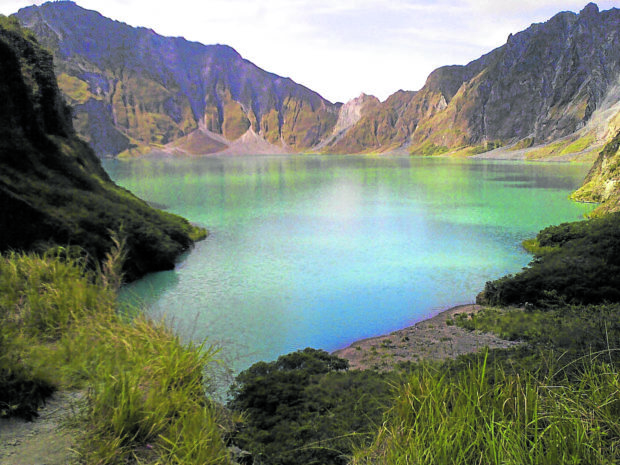
SILENT FOR NOW The crater lake formed after Mt. Pinatubo erupted in 1991, shown in this file photo, has become a major attraction for outdoor enthusiasts, with trails opened in Tarlac and Zambales provinces. The Philippine Institute of Volcanology and Seismology has put Pinatubo under alert level 1, indicating weak unrest and with no major activity detected on the volcano. —INQUIRER PHOTO
MABALACAT CITY, Pampanga, Philippines — Trisha Carlos, a 17-year-old senior high school student in this city in Pampanga, could not imagine the hardship her parents, uncles, and aunts had to endure to attend their classes after Mt. Pinatubo erupted 30 years ago.
She was listening intently as her older relatives recalled in a conversation how they had to cross the Abacan River twice daily to attend school in Angeles City.
“Hindi ko yata kaya ang ganon (I don’t think I can manage that),” she said after learning that students had to walk on a series of narrow makeshift wooden footbridges across portions of the river and climb wooden stairs to get to the other side of the highway.
On good days, when the water was shallow enough, passenger-filled public utility vehicles could cross to the other side. But it was a different story when it would rain upstream and lahar would flow through the channel.
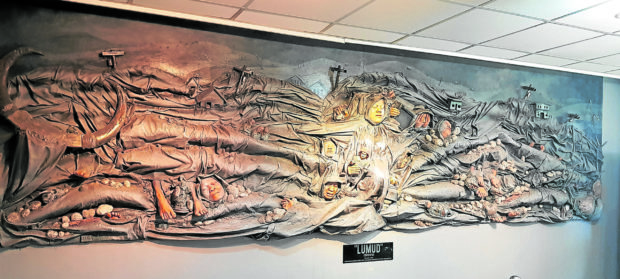
VOLCANO’S FURY Among the features of the Pinatubo Museum at the Center for Kapampangan Studies in Holy Angel University is Arnel Garcia’s mural sculpture, titled “Lumud” (Drown), which remembers those who died in lahar rampages in Pampanga from 1991 to 1995. —JUN A. MALIG
“There were times we had to wait for several hours on one side (Angeles City side) of the Abacan River until lahar subsided. We were hungry and desperately wanted to go home but there was no way to get across. We could not even contact our parents to assure them that we were safe,” Trisha’s uncle told her.
Article continues after this advertisementHe added: “There were no cell phones to text or call them during those days. Sometimes, it was already late at night when we finally got home.”
Article continues after this advertisementTrisha was dumbfounded. She could not even imagine what it was like to live without a smartphone.
‘Dark moment’
To those who experienced the hardships of how to live and adapt to varying situations during and after the catastrophic eruption of Mt. Pinatubo, that dark moment in history was not something to forget.
How could they forget the terrifying moments when the bright, rainy afternoon of June 15, 1991, suddenly turned into a very dark night and mud rained down from the sky? How could they forget how the subsequent lahar flows buried densely populated communities in a blink of an eye?
This was the primary reason why the Center for Kapampangan Studies at the Holy Angel University (HAU) in Angeles City decided to establish a Pinatubo Museum in 2016.
“We opened the Pinatubo Museum to mark the 25th anniversary of the eruption five years ago. The larger objective is to build a place where those who went through it can revisit the experience and those who weren’t born yet can understand what we went through,” HAU vice president Robby Tantingco, director of the Center for Kapampangan Studies, told the Inquirer.
“The museum also aims to explain the whole story of the volcano itself—its birth, its growth, its previous eruptions, its role in shaping the landscape and mindscape of Kapampangans,” he added.
Tantingco said younger people and students were usually confounded after visiting the museum.
“After they see the mural timeline, the exhibits and especially the video, they express disbelief that this was what their parents went through. They had heard a few stories before, but they really never had a clear and complete idea of what really happened,” he said.
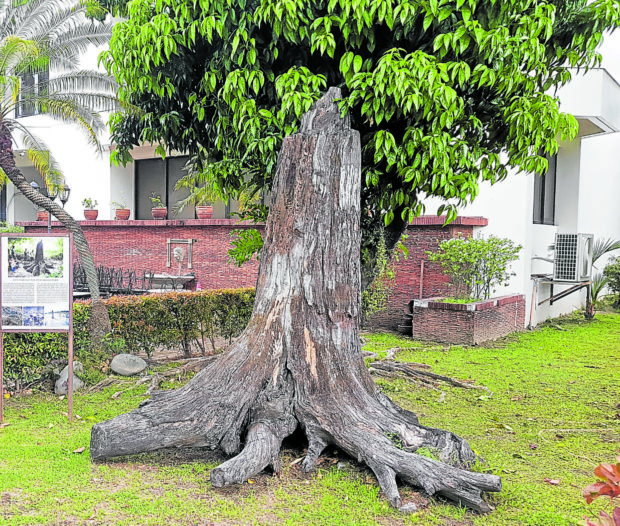
A prehistoric tree trunk found along the Abacan River and donated by officials of Barangay Pampang in Angeles City to the Pinatubo Museum.
Mural, exhibits
Inside the museum were a mural timeline of the volcano, works of local artists, comparative charts and archaeological exhibits that include a petrified tree stock recovered from the lahar that flowed along the Abacan River. Radiocarbon dating analyses revealed the tree was 2,970 years old when it was found shortly after Pinatubo’s eruption.
Tantingco said the Pinatubo Museum was the second of its kind in the Philippines. The other museum dedicated to a volcano is in Albay province where Mayon Volcano is located.
At the San Guillermo Parish Church at Barangay Cabetican in Bacolor town, there is a gallery of old photos and paintings depicting life in Pampanga before and after Mt. Pinatubo erupted. One photo shows the half-buried parish church after lahar devastated the community around it.
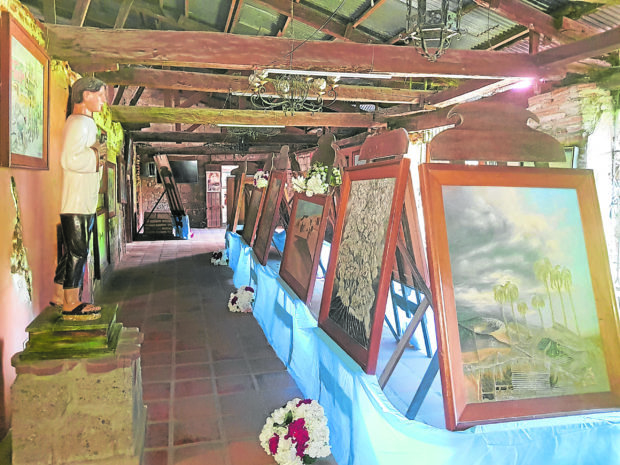
A gallery at San Guillermo Parish Church in Bacolor, Pampanga province, shows artworks depicting the experiences of the Kapampangan people in the aftermath of Mt. Pinatubo’s eruption 30 years ago.
A museum visitor noticed a drawing of a woman seated on a chair as it was being carried by two men.
“What does this mean?” she asked her companions. “She was riding a Pajero to cross the Abacan River,” one of her companions replied.
At the height of the lahar onslaught during the first half of the 1990s, enterprising individuals came out with different means of “transport” to bring commuters to the other side of the river for a fee.
The man-carried chair was called “Pajero,” referring to a popular sport utility vehicle model of Mitsubishi, while the “gareta” (carabao-drawn cart) was called “L-300,” a lower-end model marketed as a family vehicle.
Students and workers had to choose between a pajero or an L-300, which is cheaper than the first, to cross the river when the lahar flowing along the river was too deep for passenger jeepneys and makeshift wooden footbridges.
Another parish church that reminds people about the devastating eruption of Mt. Pinatubo can also be found in Cabetican, Bacolor.
Next to the new church building is the old lahar-buried place of worship now known as the Sunken Shrine of Our Lady of Lourdes. The cave-like structure has become one of the popular Visita Iglesia destinations in Pampanga during Lent.
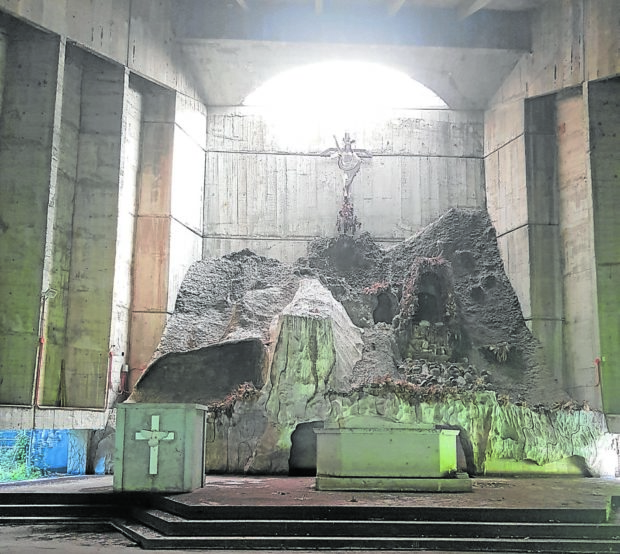
Photo shows the Sunken Shrine of Our Lady of Lourdes also in Bacolor. —PHOTOS BY JUN A. MALIG
The hardened lahar on the altar was kept to remind people about Mt. Pinatubo’s wrath. INQ
